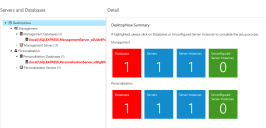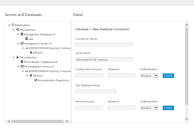Databases
In this section:
Database Summary
The Database node displays the product Database Summary page, where you can see a list of all Database Connections and create or delete them.
Create a Database
You can create databases for both the Management and Personalization servers.
-
Select the required node:
- Management > Management Databases
- Personalization > Personalization Databases
The product Database Summary page displays in the work area.
-
Click CREATE NEW.
The New Database Connection page displays.
- Enter a Connection Name for the database.
- Click in the Server Name field to display a drop down of all known SQL servers. Select the required server.
- Enter the Username and Password for the Configuration account.
-
To create a new database, ensure the configuration account has dbcreator server privileges and enter a unique database name.
- To set up the schema on a new empty database, ensure the configuration account is the database owner or a member of the db_owner role, and select the database from the list.
- To upgrade an existing database, the configuration account must have dbo privilege, and the database must be selected from the list.
Always backup your database before performing an upgrade.
- To use an existing database, the configuration account must be a member of the ManagementServerAdministrator or dbo database roles.
For further details on the Configuration and Service accounts, see Database Accounts and Privileges.
-
Select the Authentication Type:
- Windows Authentication - A Windows account and password must be specified to access the database.
- SQL Authentication - An SQL Authentication account must be specified to access the database. Accounts, including both username and password, are created in the SQL Server itself rather than making use of existing Windows domain accounts.
- Click CHECK to validate the credentials.
- Click in SQL Database Name to display a dropdown of all known databases. Select the required database. Or enter a new name to create a new one.
-
Enter the Username and Password for the Service Account.
The Web Services and Windows Services use these credentials for the database connection.
-
Select the Authentication Type:
- Windows Authentication: A Windows
username and password must be supplied each time access to the database
is required.
Note that local Windows accounts are not supported - a domain account must be used. - SQL Authentication: Specify an SQL Authentication account to provide access to the database.
Accounts, including both username and password, are created in the SQL Server itself rather than making use of existing Windows domain accounts.
If the Service account does not already exist in the SQL Server and the Configuration account has securityadmin server privileges, a new account is created.
- Windows Authentication: A Windows
username and password must be supplied each time access to the database
is required.
- Click CHECK to validate the credentials.
-
Click CREATE to start the database creation.
Once created, the database displays in the tree structure under the relevant Database node.
Edit a Database Connection
You can edit databases for both the Management and Personalization servers.
-
Select the required node:
- Management > Management Databases
- Personalization > Personalization Databases
The product Database Summary page displays in the work area.
- Select the database node that you want to change. The database Detail page displays in the work area.
- Amend the user name for the Configuration Account.
- Enter the Password.
-
Select the Authentication Type:
- Windows Authentication: A Windows account and password must be specified to access the database.
- SQL Authentication: An SQL Authentication account must be specified to access the database.
Accounts, including both username and password, are created in the SQL Server itself rather than making use of existing Windows domain accounts.
To upgrade an existing database, the configuration account must have dbo privilege, and the database must be selected from the list. Always back up your database before performing an upgrade.
To use an existing database, the configuration account must be a member of the ManagementServerAdministrator or dbo database roles.
- Click CHECK to validate the credentials.
- Amend the username and for the Service Account.
- Enter the Password.
-
Select the Authentication Type:
- Windows Authentication: A Windows username and password must be supplied each time access to the database is required.
- SQL Authentication: Specify an SQL Authentication account to provide access to the database.
Accounts, including both username and password are created within the SQL Server itself rather than making use of existing Windows domain accounts.
If the Service account does not already exist in the SQL Server and the Configuration account has securityadmin server privileges, select Create SQL Account and a new account is created.
- Click CHECK to validate the credentials.
- Click SAVE CHANGES to save the details.
Configure Personalization Databases with Low SQL Privileges
Personalization Server uses an SQL Server database to store personalization data. The installation procedure requires sysadmin access to the SQL Server instance in order to create and initialize the personalization database. When the person installing the Personalization Server does not have sysadmin access, scripts can be exported to enable the database to be set up. It is assumed that the SQL Server instance is on a separate machine to the Personalization Server.
Scripts can only be exported using PowerShell and not from the Server Configuration Portal. For more information on PowerShell scripts, see the Server Configuration Portal Scripting Guide.

